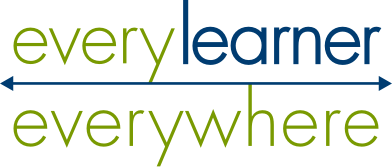High-quality digital learning depends on creating a student-centered learning environment. That is an ongoing process requiring continuous improvement and reflection. But a reliable way to check that your program is centering students is to ensure that you are using three foundational practices: equity-minded design, being informed by students, and deploying digital tools to foster inclusion and equity.
Equity-minded design
Equity-minded design makes the subject matter relevant to students. Learners identify themselves with the course and its content; because students feel seen and that they matter, they are more motivated. It aligns students’ characteristics, interests, learning needs and goals with the course content, activities and assessments.
Equity-minded design has rigor and does not mean a reduction in rigor or lowering standards. Academic challenges support student learning and growth with cognitive challenges coupled with our support and our beliefs in students’ capacity for success. It is a form of deficit-based thinking to assume that inclusion means there is a need to lower standards. A student-centered learning perspective instead looks for the institutional performance gaps and the ways in which the college or university is “at risk” of not successfully serving every learner.
Equity-minded design integrates holistic institutional and community supports, because what happens outside of the classroom directly impacts what happens inside the classroom. Faculty can normalize student support as a regular part of academic progress by including supports on the syllabus, integrating institutional and community-based support services into your course activities to help reduce stigma, and by building presence in the digital learning space, often your Learning Management System (LMS), to help faculty and students get to know each other.
Equity-minded design engages empathy. Empathetic principles to instruction and the learning experience can include intentional reflection time and brief “check-in” activities. An equitized syllabus conveys the message that the instructor cares about the student’s own goals and their success.
Equity-minded design rethinks assessment to center purpose, authenticity, and transparency. A good practice is to center students in the development of assessments.
Learn more: Course Redesign for Multiple Modalities to Support Student Success
Informed by students
A student-centered learning environment seeks out and uses students’ perspectives and experiences. Consider these practical ways that programs and individual faculty can be more informed by their students:
- Use a first-day confidential survey to alleviate tension, measure prior knowledge/skills, and identify preferred ways of demonstrating learning.
- Design a piece of the course to amplify student voice and increase student choice.
- Use progress “inquiries” that regularly ask students for their feedback and input.
- Use an additional survey halfway through the course to check in on whether students feel course content is responsive to their learning contexts.
- Monitor data dashboards to identify individual and general learning needs and continue to tailor your instruction to meet these needs.
Learn more: Taking a Holistic and Culturally Sustaining Approach to Serving HSI Students
Using digital tools to foster inclusion and equity
A student-centered learning environment can use digital tools in innovative ways to support inclusion and equity. For example:
- Syllabi can include a welcome video or other special messages from the instructor. This can also work in face-to-face classes if the syllabus is sent to students ahead of the first day of class.
- Data from the LMS and courseware data can be used to help students understand their own progress and where they need to put more attention.
- Polling or survey tools can be used to get quick practical feedback while communicating care.
Center students by conveying care
Student-centered learning environments ask what teaching strategies convey to students that instructors care about their success and how course design can encourage and validate students’ diverse perspectives, identities, and cultural contexts.
There are many possible answers to those questions, but three reliable ways to get started are prioritizing equity-minded design, making decisions that are informed by students, and using digital tools in ways that foster inclusion and equity.
Learn how Every Learner can help your program create student-centered learning environments

